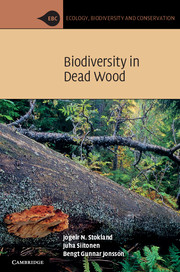Book contents
- Frontmatter
- Contents
- Preface
- 1 Introduction
- 2 Wood decomposition
- 3 The saproxylic food web
- 4 Other associations with dead woody material
- 5 Host-tree associations
- 6 Mortality factors and decay succession
- 7 Microhabitats
- 8 Tree size
- 9 The surrounding environment
- 10 Evolution of saproxylic organisms
- 11 Species diversity of saproxylic organisms
- 12 Natural forest dynamics
- 13 Dead wood and sustainable forest management
- 14 Population dynamics and evolutionary strategies
- 15 Threatened saproxylic species
- 16 Dead wood in agricultural and urban habitats
- 17 The value and future of saproxylic diversity
- References
- Index
13 - Dead wood and sustainable forest management
Published online by Cambridge University Press: 05 June 2012
- Frontmatter
- Contents
- Preface
- 1 Introduction
- 2 Wood decomposition
- 3 The saproxylic food web
- 4 Other associations with dead woody material
- 5 Host-tree associations
- 6 Mortality factors and decay succession
- 7 Microhabitats
- 8 Tree size
- 9 The surrounding environment
- 10 Evolution of saproxylic organisms
- 11 Species diversity of saproxylic organisms
- 12 Natural forest dynamics
- 13 Dead wood and sustainable forest management
- 14 Population dynamics and evolutionary strategies
- 15 Threatened saproxylic species
- 16 Dead wood in agricultural and urban habitats
- 17 The value and future of saproxylic diversity
- References
- Index
Summary
This chapter presents various forestry practices, from modest selective timber harvesting to plantation forestry. Particular attention is paid to differences in the amount, quality and dynamics of dead wood between managed and natural forests. The chapter also discusses management options and processes that might improve conditions for saproxylic species.
Many kinds of forestry practice exist, but it is beyond the scope of this chapter to give a full treatment of all aspects. Common to all types of forestry is the fact that trees are cut and removed from the forest. This clearly represents a situation of resource competition for the species dependent on dead wood. In many regions, clear-cutting and removing all the trees is the most common harvesting method and has obvious negative effects on many saproxylic species (Figure 13.1). But other management regimes also show negative effects on the dead wood biota. Balancing the extraction of wood with the demands of saproxylic species is a difficult task – a topic that is discussed in the second half of this chapter.
Amount, quality and dynamics of dead wood in managed forests
The most obvious ef ect of forestry is the extraction of trees for commercial purposes. This will result in a loss of dead wood resources for saproxylic species, in terms of quantity, quality and dynamics.
- Type
- Chapter
- Information
- Biodiversity in Dead Wood , pp. 302 - 337Publisher: Cambridge University PressPrint publication year: 2012
- 7
- Cited by



